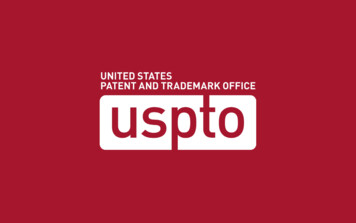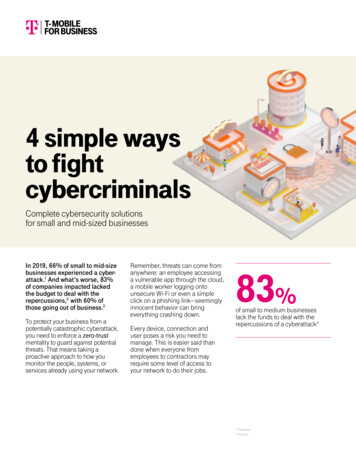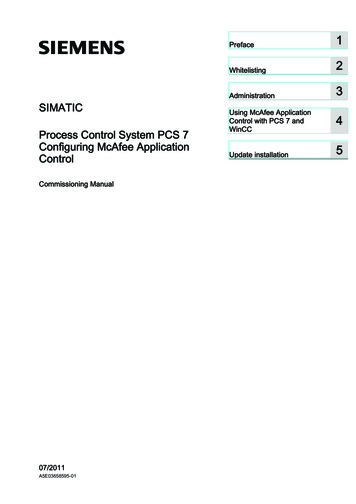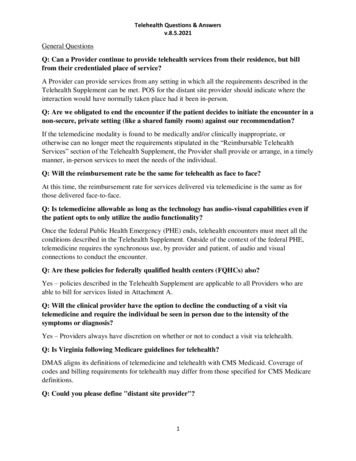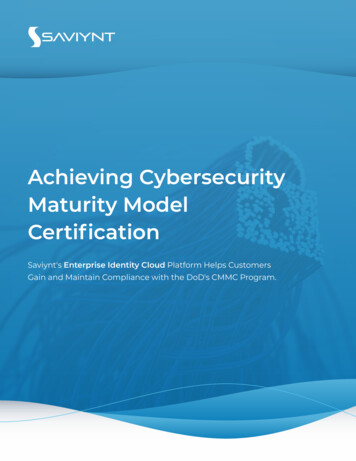
Transcription
WHO PROTECTSTHE PROTECTORS?QUIS CUSTODIET IPSOS CUSTODES?Cybersecurity Industry:State of the ExternalAttack Surface2022Data Powered by Reposify. All Rights Reserved 2022
Cybersecurity Industry: State of the External Attack SurfaceTable of ContentIntroduction3About this Report4Key Findings5Exposed Services Overview6Sensitive Exposed Platforms7Exposed Remote Access Protocols8Exposed Databases9Exposed Storage & Backup Assets10Exposed Development Tools11Exposed Web Servers12Common Cloud Providers with Exposed Assets13Common Exposed Services & Categories in Cloud Environments14Known vs. Unknown Exposures15Risk Overview16High & Critical Security Issues17Implications & Recommendations18About Reposify19Appendix - Index of Terms202Data Powered by Reposify. All Rights Reserved 2022
Cybersecurity Industry: State of the External Attack SurfaceIntroductionSprawling digital footprints create massive blind spots for IT and security teamsModern business is online. Fast-paced growth involves a constant expansion of a company’s digitalfootprint, creating major blind spots for security teams. Organizations evolve in the cloud, formsubsidiaries, are transitioning to hybrid workspaces and rely on third-party vendors more than everbefore. A study by the Enterprise Strategy Group (ESG) found that 70% of companies use more than10 tools to manage security hygiene and posture. Digital footprints are sprawling and decentralized,making asset management far more difficult for IT and security teams.Unknown assets are consistently ranked as modern businesses’ main cybervulnerabilityThe result is a complex and ever-growing attack surface that leaves companies vulnerable to cyberthreat. External attack surface management becomes extremely challenging for every industry,especially without proper visibility or control mechanisms in place. This has reinforced the need forresilient, thorough cybersecurity posture. Eighty-six percent of organizations believe they follow bestpractices for security hygiene and posture management. However, 69% admit they have experiencedat least one cyberattack that started through the exploit of an unknown or unmanaged internet-facingasset, according to the aforementioned ESG report.Furthermore, a recent MIT Technology Review poll found that 51% of Asia-Pacific companies blamecyberattacks on unknown assets. In the same poll, 43% of respondents confirm more than half of theirdigital assets are stored in the cloud, while 67% of companies mark continuous asset monitoring as acornerstone of a strong cybersecurity strategy.Cybersecurity is essential for digital business; but are cybersecurity leaderspracticing what they preach?With nearly every industry at risk, are cybersecurity companies truly as cyber-secure as the world wouldlike to think? Worldwide security and risk management spending exceeded 150bn USD in 2021. With everytool at their disposal, is the cybersecurity industry taking advantage of its know-how to protect itself?While it works to protect other vulnerable industries from cyberattack, the industry has forgotten to askitself a critical question: who protects the protectors?3Data Powered by Reposify. All Rights Reserved 2022
Cybersecurity Industry: State of the External Attack SurfaceAbout this ReportReposify’s Cybersecurity Industry: State of the External Attack Surface 2022 report examines the securityposture of the cybersecurity industry, and delivers unique insight into the external attack surface ofthe world’s leading cybersecurity companies.This report presents information about prevalent exposures of services, sensitive platforms, CVEs andother security issues among 35 multinational cybersecurity companies, and their 350 subsidiaries,with an average of 9 subsidiary companies per multinational firm. The State of the External AttackSurface report identifies high or critical issues facing the cybersecurity industry today.Reposify’s technology scans the internet 24/7 for known and unknown assets, indexing over 500million assets each month. The technology preempts potential breaches by mapping the internet forany exposed assets: cloud services, external-facing on-premise infrastructures, IoT infrastructures,web assets, development tools and more.The data in this report was derived from Reposify’s external attack surface management (EASM)platform, and discovered a total of 258.2 million exposed assets during a two-week window inJanuary 2022. At this same period of time, 35 cybersecurity companies were found to host over200,000 exposed assets.35Multinational cybersecuritycompaniesAverage of92Subsidiaries per acybersecurity companyweeks time4Monitoring thecybersecurity industryData Powered by Reposify. All Rights Reserved 2022
Cybersecurity Industry: State of the External Attack SurfaceKey Findings97%91%have exposed assets in AmazonApache hosted exposed assets.of web servers identified as Nginx andof security companies mappedWeb Services (AWS) cloud services.86%51%at least one sensitive remote accessleast one exposed database thatof security companies analyzed haveservice exposed to the internet.42%of security companies have atcould lead to potential leakage.of the exposed assets discovered on the Reposifyplatform were identified with high-severity issues.5Data Powered by Reposify. All Rights Reserved 2022
Cybersecurity Industry: State of the External Attack SurfaceExposed Services OverviewReposify’s EASM platform analyzed the prevalence of exposed sensitive services among cybersecuritycompanies. The results support a trend across several industries to better index their assets, particularly asdigital transformation, work-from-home policies and an increased reliance on cloud services takes hold.86% of cybersecurity companies analyzed have at least one sensitive remote access service exposed tothe internet; a trend that is only set to continue as work from home becomes the norm.80% of companies have exposed network assets; reflecting the impact of decentralized IT control.63% of companies have exposed back office internal networks demonstrating that even internalconfigurations are not immune to cyberattack.51% of companies have at least one exposed database that is sensitive to attack from malactors.As critical houses of a companies’ sensitive information, these are attractive targets for hackers.40% of companies have exposed development tools, reinforcing the need for companies to continuallyupdate tools across the organization to help prevent attack.37% of companies have exposed storage and backup tools, should these be compromised, services maybecome unavailable, and permanent and private information may be lost.Percent (%) of cybersecurity companies with exposedservices (by platform category)6Data Powered by Reposify. All Rights Reserved 2022
Cybersecurity Industry: State of the External Attack SurfaceSensitive Exposed PlatformsSensitive exposed platforms span remote access platforms, development tools, storage and backups,remote communication tools among others. These asset categories are highly sensitive, and theconsequence of a breach is severe - particularly in the case of the cybersecurity industry. Each vulnerabilityrepresents a possible entry point to an attacker; it’s critical they be protected.91% of web servers identified as Nginx and Apache hosted exposed assets.88% of exposed platforms were accessible via OpenSSH. This is unique to the cybersecurity industry,compared to Reposify assessments of the financial sector and pharmaceutical industry.IIS followed closely with 85% of cybersecurity companies having a exposed asset on the platform.Portmap, an open network computing remote procedure call (ONC RPC), saw 50% of cybersecuritycompanies with exposed assets on the platform.Percent (%) of cybersecurity companies with sensitiveexposed platformsNginxApacheOpenSSHIIS7Data Powered by Reposify. All Rights Reserved 2022
Cybersecurity Industry: State of the External Attack SurfaceExposed Remote Access ProtocolsThe demand for remote access platforms has skyrocketed as employees transition to the homeenvironment in the aftermath of the COVID-19 pandemic, and many companies embrace global remotehiring practices. Findings in exposed remote access platforms for the cybersecurity industry mirror that ofother industries – with similar figures cropping up in an examination of finance and pharmaceutical industryexposed remote access platforms.OpenSSH had nearly twice the amount (90%) of exposed assets compared to RDP (47%), whosenumber of exposed assets increased by 127% in the early months of the COVID-19 outbreak asemployees transitioned to the home environment.Telnet (33%) and service message block (SMB) services (30%) follow for a near-tie in third place.Percent (%) of security companies withexposed remote access protocolsOpenSSH8Data Powered by Reposify. All Rights Reserved 2022
Cybersecurity Industry: State of the External Attack SurfaceExposed DatabasesDatabases are among the most vulnerable to cybersecurity threat. The Reposify platform identified over half(51%) of companies host an exposed database.Reposify has found that out of the companies identified as having exposed database, 72% haveexposed PostgreSQL databases, followed by Oracledb with 50%.MySQL and Microsoft SQL are the least exposed database platforms - with 28% and 21% respectively.Percent (%) of security companies withexposed databasesPostgreSQLMySQL9Microsoft SQLData Powered by Reposify. All Rights Reserved 2022
Cybersecurity Industry: State of the External Attack SurfaceExposed Storage & Backup AssetsFTPs are used for file sharing within external networks. Though FTPs are incredibly useful as a communicationprotocol, it’s best practice to avoid use altogether as they lack built-in authentication. Reposify’s researchfound that the majority of FTPs were either not behind a VPN or set up to allow for “anonymous authentication”,which allows the user to login without a username or password for verification.Though the number of cybersecurity companies with exposed assets in FTP storage is significantly lower thanthat of the financial and pharmaceutical industries, the patterns are not dissimilar as FTPs represent a majorityof the risk across all industries, according to research by Reposify.Despite best practice to avoid them altogether, 57% of cybersecurity companies have exposed FTP services.Exposer were also found on S3 (14%), Azure Blob Storage (9%) and rsync (6%) - but at a significantly lowerrate than that of FTPs.Percent (%) of companies with exposed storage & backup assets10Data Powered by Reposify. All Rights Reserved 2022
Cybersecurity Industry: State of the External Attack SurfaceExposed Development ToolsDevelopment tools can become high risk assets if misconfigured, or failure to regularly update toolsto the latest version. When left out of date, dev tools can easily leak information such as source code,business analytics, unprotected API endpoints and more.The exposure of these tools is especially problematic as it can increase the probability of a supplychain attack. Malicious code can be added to an otherwise legitimate application, like SolarWinds, PHPrelated services, CodeDev and others.50% of cybersecurity companies using Express had exposed development tools.Tableau server and jenkins saw 21% and 29% of companies with exposed development tools ontheir servers.Percent (%) of companies with exposedDev Tools11Data Powered by Reposify. All Rights Reserved 2022
Cybersecurity Industry: State of the External Attack SurfaceExposed Web ServersWeb server vulnerabilities are continually changing. SQL Injection, Cross-Site Scripting (XSS), Distributed Denialof Service (DDoS) or Cross-Site Request Forgery (CSRF) are just a few methods attackers use to infiltrate webservers, but as digital solutions become more sophisticated, so will the means of attack.Reposify found that Nginx (83%) and Apache (80%) were the most common web servers with exposedassets.Closely following them was internet information services (IIS), with 66% and Gunicorn with a significantlylower 11%.Percent (%) of companies with exposed web servers TOP 4 sensitive web serversNginxGunicorn12Data Powered by Reposify. All Rights Reserved 2022
Cybersecurity Industry: State of the External Attack SurfaceCommon Cloud Providers with Exposed AssetsThough cloud computing has come under fire for its associated cybersecurity risks, the market is projectedto hit 791.48bn USD by 2028, spurred on by demand for real-time information from any location, theintegration of big data, AI and ML, and cloud-based solutions becoming the norm during the pandemic.Key players in the space include: AWS, Oracle, IBM and Microsoft Corporation, among others.Reposify analyzed the top cloud providers to assess the number of cybersecurity companies with exposedassets in the cloud, with critical findings.Nearly all – 97.14% – of cybersecurity companies hosted exposed assets in Amazon Web Services(AWS) Cloud platform.Microsoft Azure followed with 82%, and Google coming in with 76%.Percent (%) of companies with exposed cloud assetsper each cloud providerMicrosoft Azure13Data Powered by Reposify. All Rights Reserved 2022
Cybersecurity Industry: State of the External Attack SurfaceCommon Exposed Services & Categories in Cloud EnvironmentsFurther analysis of the top three cloud providers with vulnerabilities revealed the most exposed assetcategories and platforms. Reposify focused on the following categories: databases, development tools (eg.express, Jetty, RDi/IBM Rational), internal network assets (eg. memcheshed, portmap), remote access (eg.openSSH, RDP) and storage and backup (FTP).As seen in the exposed remote access category, OpenSSH saw 89% of cybersecurity companies withexposed assets. RDP and SMB followed with 20% and 9% respectively.Under network assets, Memcached saw 23% of companies hosting exposed assets, followed by SMTPat 17%, and Portmap with 11%.Development Tools on the cloud were also vulnerable, with rational team concert hosting 49% ofexposed assets, express with 40% and Jetty with 23%.Finally, databases MySQL saw 14% of cybersecurity companies exposed, followed by PostgreSQL andSQL Server with 6% each.Percent (%) of companies with Exposed Services &Categories in Cloud Environments14Data Powered by Reposify. All Rights Reserved 2022
Cybersecurity Industry: State of the External Attack SurfaceKnown vs. Unknown ExposuresTo gauge companies’ awareness of exposures, Reposify analyzed the distribution of services across thenetwork perimeter using it’s advanced artificial intelligence technology. This determines if services areattributed to known or unknown network perimeters. Services under known perimeters are likely to be on asecurity teams’ radar, and therefore will be periodically monitored. Services under unknown perimeters areless likely to be known, and often represent shadow IT, unknown risks, or flag a possible backdoor malactorscan use to access a company’s assets.Distribution of services across official & unofficial perimeter selected asset categoriesOfficial PerimeterUnofficial PerimeterSeindxoftrmspag20-2115Data Powered by Reposify. All Rights Reserved 2022
Cybersecurity Industry: State of the External Attack SurfaceRisk OverviewReposify’s research team analyzed the prevalence of key risks which are visible from an external pointof view, and could be leveraged by potential attackers. These risks include known vulnerabilities, likemisconfigurations and human error.Various security issues were identified – ranging from low- and medium-severity (eg. highly complexlow exploitation probability or lower risk issues) to critical severity (eg. potential remote code execution).Reposify gathered data over a period of two weeks (January 2022) for this report, during which 258.2 millionexposed assets were discovered across all industries.30% of issues discovered by Reposify’s platform were categorized as high severity, and 12% as critical severity.Meanwhile, 58% of issues discovered were categorized as medium severity.All security issues discovered(by risk severity: medium, high-critical)CriticalHighMedium12%58%42%30%* Findings refer to actual systems with public IP exposed meaning having actual exploitation possibilitiesand it’s distribution over the scanned systems/assets16Data Powered by Reposify. All Rights Reserved 2022
Cybersecurity Industry: State of the External Attack SurfaceHigh & Critical Security IssuesReposify analyzed the number of services affected by security issues with high and critical CVSS scores.Vulnerable software and improper access control issues were the most common issue categories.Percent (%) of security companies with open CVEs(per issue category)17Data Powered by Reposify. All Rights Reserved 2022
Cybersecurity Industry: State of the External Attack SurfaceImplications & RecommendationsThe cybersecurity industry has done an incredible job of protecting its clients. Now, the industry must paythat same attention to themselves. Companies are embracing digital transformation, moving to cloudbased services, encouraging employees to work from home and often use mobile phones to access workemail, documents and servers. These changes represent incredible opportunity - but also incredible risk asunknown assets multiply and hackers become more sophisticated in their methods of attack.As analyzed in this report, exposed assets can be found across development tools, cloud service providers,web servers, databases and remote access platforms – all of which can be used by malactors as anentry point. Cybersecurity companies must harden their security to make it more difficult for attackersto gain a foothold in their systems, beginning with a clear view of their external attack surfaces andcontinuous monitoring and elimination of risky attack vectors.External attack surface management (EASM) tools provide these services seamlessly. Defined in the HypeCycle for Security Operations, 2021 Gartner Report as “the processes, technology and managed servicesdeployed to discover internet-facing enterprise assets and systems and associated vulnerabilities.”EASM is the sum of all digital doorways into an enterprise, and is critical to any enterprise cybersecuritymanagement strategy.In addition to identifying known and unknown assets, EASM goes one step further by evaluating andanalyzing assets to determine high risk or vulnerability, and prioritizing based on this risk assessment. Now,CISOs can use EASM for actionable insight to determine where further investment is needed to improveoverall security posture.In this report, Reposify uncovered that nearly 100% of companies analyzed host vulnerable assets onAmazon Web Services. Over half of security companies have at least one exposed database, which couldlead to millions in damages and insurmountable data loss or leakage. Meanwhile, 86% of companies haveexposed remote access services, reinforcing the need for more thorough cybersecurity management asthe workforce shifts to the home environment. Just one of these statistics is concerning enough – but thecombination points to a sincere need for the industry to better practice what it preaches.18Data Powered by Reposify. All Rights Reserved 2022
About ReposifyReposify is the leading External Attack Surface Management (EASM) provider. By mapping theweb in real-time, 24/7, Reposify enables security teams to discover and eliminate unknownexposures and shadow IT risks across all environments with no agents or deployment required.Reposify delivers an up-to-date view of a company’s exposed asset inventory, analyzes andprioritizes every asset and generates a plan with actionable insights so teams can resolvemore issues in less time.Leading enterprises worldwide use Reposify to protect their digital footprint and eliminateshadow IT risks in real-time.Reposify is a Gartner Emerging Vendor in the EASM space.Let’s 9Data Powered by Reposify. All Rights Reserved 2022
Cybersecurity Industry: State of the External Attack SurfaceAppendix - Index of TermsAttack SurfaceAny software, application, or network has an attack surface which is the sum of all points whereunauthorized users can try to access the data or steal it from that certain IT environment.Cyber RiskCybersecurity risk is a potential exposure of an IT network or a system environment that can result inextensive harm to critical assets or loss of sensitive data within an organization’s network.External Attack SurfaceThe external surface is any exposed server or IoT device with a public-facing IP address, related to yourorganization that potential attackers could leverage to break into a network, gain access to corporatedata and use your resources without authorization.External Attack Surface Management‘EASM’ solutions are specially designed for organizations to gain instant visibility into all of the IT networkexposed assets and its security posture with real-time and ongoing discovery of unknown risks andexposures. EASM solutions provide the ability to get an always up-to-date view of all your assets allowingorganizations to fully maximize the current tools used by the organization.Known AssetsAssets an organization knows about, manages, and monitors on a daily basis. It includes servers, webfacing applications, and other services. These assets are usually used on a daily basis.Official PerimeterOfficial perimeter or registered perimeter is an IP address that is publicly known and registered to yourorganization’s IT network. The official perimeter is part of an organization’s asset inventory, which holdsthe current exposed services of a specific network.Security BreachAny incident that results in a sort of unauthorized access to network data, application, or device is calleda security breach. This means that secure information can be intentionally or unintentionally accessed.Shadow ITImplemented resources or applications that are unknown or unapproved by the IT department within theorganizations’ network, is called Shadow IT. These assets refer to computer services, hardware devices, orcloud services of any kind that were installed inside the IT environment of an organization without the ITdivision knowing about its existence.Unknown AssetsA major part of an organization’s “unofficial perimeter”. These assets are not part of the organization’sformal external profile. Here you may find various test servers, IoT devices, login pages, and temporaryservices that are exposed either by accident, misconfiguration (often default settings), or by human error,for example, a user forgetting to take them down when deprecating or replacing them with newer services.20Data Powered by Reposify. All Rights Reserved 2022
Cybersecurity Industry: State of the External Attack SurfaceUnofficial PerimeterEvery exposed server and IoT device which are not being marked as official and recognized by anorganization as official will be identified as part of its unofficial network perimeter. Inside the unofficialperimeter are assets like shadow IT-related services, phishing sites, and staging environments.VulnerabilityVulnerability refers to any weakness a computer system or a network has that can be exploited byhackers/ cybercriminals in order to gain illegitimate access and compromise sensitive data. Onceorganizations are familiar with its vulnerabilities, security teams must work fast to patch them or facepotential cyberattacks.Vulnerability ManagementVulnerability management is the process performed for identifying, classifying, prioritizing, and reportingsecurity software vulnerabilities. Vulnerability management is a proactive approach of looking forweaknesses by scanning networks and identifying vulnerabilities and providing remediation suggestionsto mitigate the potential of security breaches so organizations can stay ahead of attackers.21Data Powered by Reposify. All Rights Reserved 2022
Tableau server and jenkins saw 21% and 29% of companies with exposed development tools on their servers. Percent (%) of companies with exposed Dev Tools. 2022 12 Exposed Web Servers Web server vulnerabilities are continually changing. SQL Injection, Cross-Site Scripting (XSS), Distributed Denial
